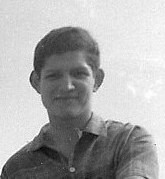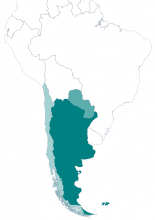Jorge 'Trosko' Fuentes Alarcón- nicknamed after his aversion to the Russian thinker, Leon Trotsky- was born on 5th February 1947. He developed an interest in politics in his popular neighbourhood on the outskirts of Santiago, where he became involved in the Juventudes Comunistas de Chile (Chilean Communist Youths, JJCC). Having completed secondary school, he travelled 500 kilometres down south to study sociology at the University of Concepción. He became a militant of the Movimiento de Izquierda Revolucionaria (Revolutionary Left Movement, MIR) upon its foundation in 1965. Jorge participated in the 1967 Congress, eventually forming part of its central committee. Jorge was a renowned student leader of the Movimiento Universitario de Izquierda (University Left Movement, MUI), serving as the representative for sociology and the president of the students' federation in the early 1970s. During the era of the left-wing Unidad Popular (Popular Unity) coalition from 1970 to 1973, Jorge engaged with the MIR's trade union and rural reform activities. He travelled to the northernmost desert region of Chile, Norte Grande, where he was the MIR leader for the Antofagasta Region. He was married, had a son, and was working as a sociologist at the Catholic University of the North's main campus in Antofagasta. He supported the early grassroots workers' movements, known in Spanish as the cordones industriales, established during the Unidad Popular (Popular Unity) government of Salvador Allende.
On 11th September 1973, Fuentes Alarcón's house was raided. At the time, he was in the city of Arica, close to the border with Peru. Fuentes Alarcón left Chile and set off for Peru before making his way to Cuba. He was accompanied by the MIR militants, Mario Espinoza, Jorge Vercelotti and Homero Tobar who were later disappeared in Argentina in 1976. The MIR's central committee directed Fuentes Alarcón to participate in the alliance of leftist guerrilla organisations known as the Junta Coordinadora Revolucionaria (Revolutionary Coordinating Junta, JCR). The mission sent him to Argentina during the second half of 1974, where he became the MIR's political leader.
Jorge's wife, Luzmila Ortiz, had remained in Chile with their son. She managed to meet her husband in France in March or April 1975, before travelling with their son to Cuba.
In Argentina, Fuentes Alarcón had received a JCR mission to contact other Latin American organisations, alongside the lawyer, Amílcar Santucho from the Partido Revolucionario de los Trabajadores – Ejercito Revolucionario del Pueblo (Workers' Revolutionary Party–People's Revolutionary Army, PRT-ERP). This led them both to leave Buenos Aires for Asunción (Paraguay) on 15th May 1975. They would then head for Lima (Peru). Amílcar Santucho was arrested first on 16th May 1975 upon reaching the Paraguayan border with Argentina at the Port of Itá Enramada. According to police records, Jorge Fuentes was detained the following day in the Hotel España in Asunción, where he was staying under the name of Ariel Nodarse Ledesma. On 14th July 1975, Jorge was interrogated in Asunción by Pastor Coronel, the Chief of the Investigations Department of the Paraguayan Policía de la Capital (Capital Police). Police records reveal that Jorge Fuentes left Paraguay via President Stroessner International Airport on 23rd September 1975. Two days later, Manuel Contreras Depúlveda, who was the Director of Chile's secret police known as the DINA, sent his sincere gratitude to Pastor Coronel for having cooperated with the DINA during its Paraguayan mission.
Fuentes Alarcón was driven to a secret DINA prison, 'Cuatro Alamos', and later taken to the clandestine detention and torture centre, 'Cuartel Yucatán' (also known as 'Villa Grimaldi') at no.8200 José Arrieta Avenue in the Peñalolén commune of Santiago Province (Chile). A testimony from the Socialist Party militant turned DINA collaborator, Luz Arce, claims that the civilian agent, Osvaldo Picetti Gac (known as 'the Sorcerer') pursued Fuentes Alarcón together with the commander of the DINA Caupolicán Brigade, Miguel Krassnoff Martchenko.
Former political prisoners of Villa Grimaldi recall having seen or heard Jorge Fuentes Alarcón who was chained to a shack or a small wooden crate on the patio. According to different testimonies, the guards made fun of Jorge, who had contracted scabies in a Paraguayan prison, by calling him 'creepy crawly' or 'doggy'. Former detainees remember the sound of Jorge Fuentes singing. Jorge was last seen in January 1976.
On 6th October 1975, an appeal began in Jorge's favour which was rejected, leading to the trial, Rol 1282-75 of San Miguel's Appeals Court. On 11th December 1975, Jorge's mother presented a criminal complaint (querella, Rol 4.648) to Santiago's Criminal Appeals Court. The case was dismissed after having been referred to the Special Investigating Judge (Ministro en Visita), Servando Jordán, who was appointed to investigate disappearances in May 1979. In 1991, a criminal complaint (querella) was filed (Rol 59.046) and a lawsuit (denuncia, Rol 62.638) was presented before Santiago's Criminal Appeals Court. In 1997, Santiago's Second Military Court disputed the verdict and the Supreme Court decided in favour of the military jurisdiction, which collated the previous lawsuits under the case, Rol 1036-97. The trial was dismissed on 16th March 1999. The Supreme Court invoked a cassation appeal on 28th August 2003 and the previous cases were collated under the lawsuit Rol 2182-98, 'Operation Condor'.
The final sentence of 21st September 2018, pronounced by Minister Mario Carroza, charged Raúl Iturriaga Neumann, Miguel Krassnoff Martchenko, Cristoph Willike Floel, and Gerardo Godoy García for the aggravated kidnapping of Jorge Fuentes and condemned three additional agents as their accomplices. Santiago's Criminal Appeals Court condemned another seven agents and raised the sentences imposed by the Court (Rol 4.545-2019).


